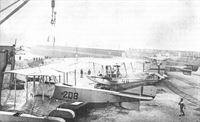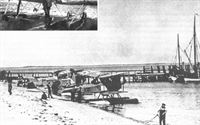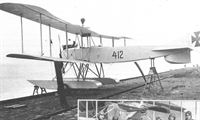
Описание
Страна: Германия
Год: 1914
Two-seat reconnaissance patrol twin float seaplane
Варианты
- Friedrichshafen - FF19 - 1914 - Германия
- Friedrichshafen - FF29 - 1914 - Германия
- Friedrichshafen - FF33 - 1915 - Германия
- Friedrichshafen - FF39 - 1916 - Германия
- Friedrichshafen - FF49 - 1917 - Германия
- Friedrichshafen - FF59 - 1918 - Германия
- Friedrichshafen - FF67 - 1918 - Германия
- Friedrichshafen - FF71 - 1919 - Германия
- O.Thetford, P.Gray German Aircraft of the First World War (Putnam)
- J.Herris Friedrichshafen Aircraft of WWI (A Centennial Perspective on Great War Airplanes 21)
- Журнал Flight
-
J.Herris - Friedrichshafen Aircraft of WWI /Centennial Perspective/ (21)
Friedrichshafen FF29 Marine Number 211 was an FF29 powered by a 120 hp Mercedes D.II.
This type, equipped with a 120 hp Mercedes D.II engine, was an enlarged version of the FF.19. Series 1 comprised 20 aircraft, series 27 (with Argus engine), series 3-5 a total of 17 aircraft. The FF29 was replaced by the FF35 from March 1915. -
Журнал - Flight за 1919 г.
F.F. 29
-
J.Herris - Friedrichshafen Aircraft of WWI /Centennial Perspective/ (21)
Friedrichshafen FF29 Marine Number 2?3 JUNGDEUTSCHLAND displays a different tail design than the other FF29 aircraft shown here.
-
K.Delve - World War One in the Air /Crowood/
Friedrichshafen developed a superb series of seaplanes during the war. The FF29, as here, was produced from late 1914 for coastal patrol duties.
-
J.Herris - Friedrichshafen Aircraft of WWI /Centennial Perspective/ (21)
Marine Number 419 was a Friedrichshafen FF33A, while Marine Number 294 was an FF29. The early FF33 and FF33A were virtually FF29 aircraft; later FF33 variants used more powerful engines, mostly the 150 hp Benz Bz.III.
Другие самолёты на фотографии: Friedrichshafen FF33 - Германия - 1915
-
A.Imrie - German Naval Air Service /Arms & Armour/
When HMS Maori, engaged in sketching salient features on the Belgian coast, hit a mine off Blankenberghe and sunk on 7 May 1915, her yard-arm and this flag remained above the water. Despite rough seas, Oberleutnant zur See Drekmann (right) landed his Friedrichshafen FF29 209. Then, with his observer, Fahnrich zur See von Bliicher, hanging on to the starboard front interplane strut with an open clasp knife held in his teeth, pirate fashion, Drekmann managed after several attempts to position von Blucher so that he could cut the flag free. A hazardous take-off followed and the plucky fliers brought their booty back to Zeebrugge. (British destroyers at sea flew either the Red Ensign or the Union Flag from their yard-arms for recognition purposes, but the Germans did not know this and were puzzled as to why a Royal Navy vessel should be flying the 'Red Duster'!)
-
J.Herris - Friedrichshafen Aircraft of WWI /Centennial Perspective/ (21)
Built in early 1914, the Oertz F.B.3 was purchased by the Navy and assigned Marine Number 46. Here it is shown at Zeebrugge in early 1915, after national markings and Marine Number have been applied between Friedrichshafen FF29 floatplanes #208 and #204. Marine Number 407 in the background is another Friedrichshafen FF29.
Другие самолёты на фотографии: Oertz FB 2/FB 3/W 4 - Германия - 1913
-
A.Imrie - German Naval Air Service /Arms & Armour/
Following the occupation of the Belgian coast, a seaplane base was established at Zeebrugge in December 1914. Aircraft were kept in the railway station hall at the end of the Mole, fully assembled on specially constructed flat railway cars which carried tools, fabric, dope, etc for minor repairs, as well as supplies of water, fuel and oil. Locomotives were kept with steam up and were always available to pull the trains out on to the Mole and up to the cranes used to lift and lower the seaplanes to the water. In this early 1915 scene no national insignia are displayed on the upper wing surfaces of these Friedrichshafen FF29 seaplanes or the Oertz flying-boat numbered 46, but wing undersurfaces were marked spanwise with the straight-sided cross, as seen on the Oertz's rudder.
Другие самолёты на фотографии: Oertz FB 2/FB 3/W 4 - Германия - 1913
-
J.Herris - Rumpler Aircraft of WWI /Centennial Perspective/ (11)
Rumpler 4B12, Marine Number 105, and an FF29 at either Flying Station List or Sylt.
Другие самолёты на фотографии: Rumpler 4B - Германия - 1914
-
Журнал - Flight за 1916 г.
LAUNCHING A GERMAN SEAPLANE. - Before the war a good many attempts were made by German constructors at producing a combined wheel and float undercarriage so as to enable machines to start from or alight on either land or sea. In the above photograph, however, the wheels and tackle on top of the floats appear to be detachable to be used probably for running the machine short distances over land, and left behind when she takes the water. The floats, it will be observed, are of the two-stepped type, the first two sections being flat-bottomed, while the portion behind tbe rear step has a Vee bottom. The flags on the lower wing tips are in all probability fitted to a cable, and movable for signalling purposes.
-
Журнал - Flight за 1917 г.
HOISTING HER HOME. - Bringing a German seaplane into its hangar by means of a crane.
-
J.Herris - Friedrichshafen Aircraft of WWI /Centennial Perspective/ (21)
Early on 6 January 1915 an FF29a was lashed to the deck of the U-Boat U-12 as an experiment to see if the submarine could take the aircraft out into the North Sea where it could perform reconnaissance duties for the submarine. The machine had to be lashed with the wings parallel to the submarine's length. Despite a fairly heavy sea the FF29a was launched successfully about 30 miles out from Zeebrugge. Unfortunately, the conditions deteriorated such that the pilot of the seaplane did not try to make the rendezvous with the submarine but flew back to base. While the idea had worked it was apparent that much more work would be required to develop a true integration of the submarine and an aircraft. This photo may have been related to that experiment.
-
J.Herris - Friedrichshafen Aircraft of WWI /Centennial Perspective/ (21)
Friedrichshafen FF29 Marine Number 410 was delivered in March 1915. Powered by a 120 hp Mercedes D.II, it was the last aircraft of the last batch of FF29 aircraft ordered.
-
J.Herris - Friedrichshafen Aircraft of WWI /Centennial Perspective/ (21)
Friedrichshafen FF29A Marine Number 412 was delivered in March 1915.
-
M.Dusing - German Aviation Industry in WWI. Volume 2 /Centennial Perspective/ (85)
Fdh FF29A (1914). The FF29A (series 5) had a redesigned fin and rudder.
-
O.Thetford, P.Gray - German Aircraft of the First World War /Putnam/
Friedrichshafen FF 29a
-
J.Herris - Friedrichshafen Aircraft of WWI /Centennial Perspective/ (21)
Friedrichshafen FF29A Marine Number 413. Powered by a 100 hp Mercedes D.I, it was from the last batch of FF29A aircraft ordered.
-
J.Herris - Friedrichshafen Aircraft of WWI /Centennial Perspective/ (21)
Friedrichshafen FF29A Marine Number 412 at Borkum. In the center is Flugmaat Elsasser, who provided these Borkum photos.
-
J.Herris - Friedrichshafen Aircraft of WWI /Centennial Perspective/ (21)
A Friedrichshafen FF29 being brought ashore.
-
J.Herris - Friedrichshafen Aircraft of WWI /Centennial Perspective/ (21)
Friedrichshafen FF29 #17 in Danish service.
O.Thetford, P.Gray German Aircraft of the First World War (Putnam)
Friedrichshafen FF 29
Built in small quantity from November 1914, the FF 29 and FF 29a (powered with 120 h.p. Mercedes D II engine) were used for coastal patrol and sometimes carried a small bomb load. No other armament was carried. The FF 29a had modified tail surfaces and floats.
Описание:




















